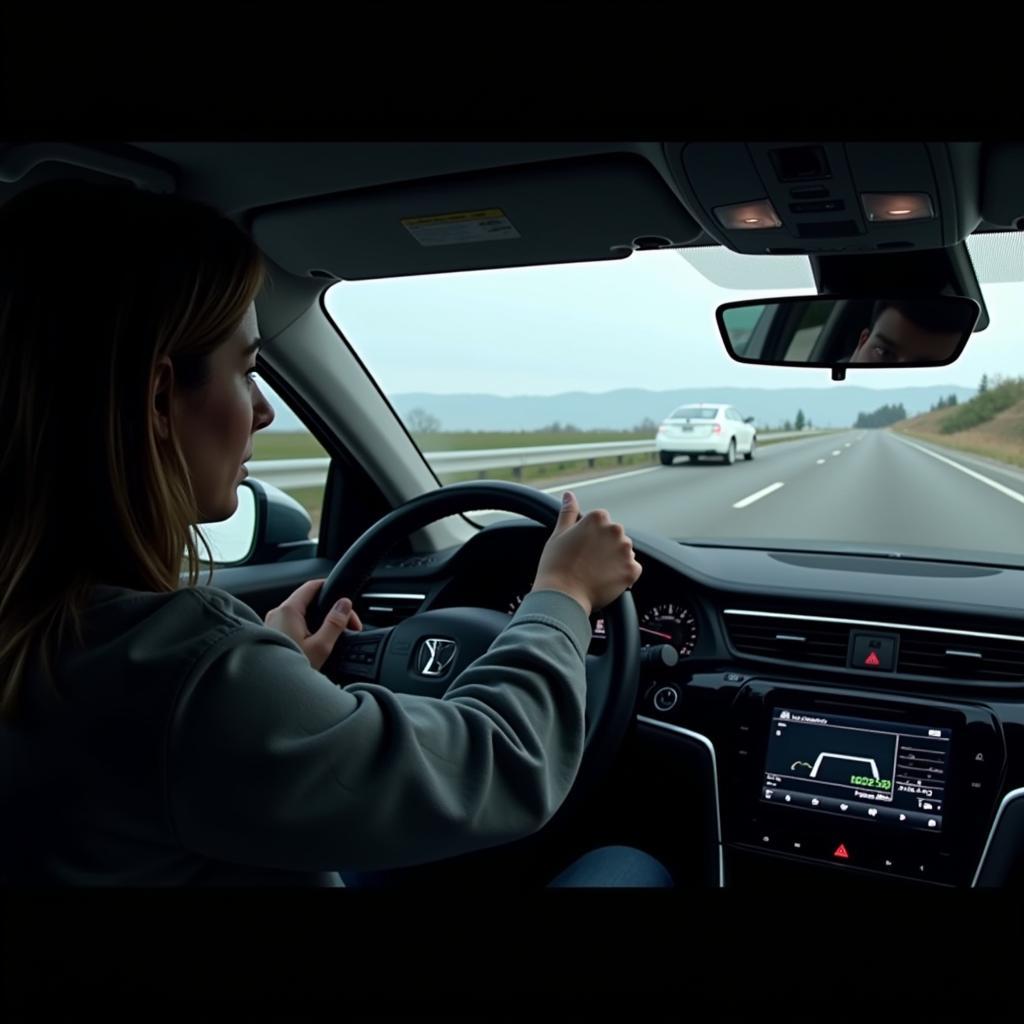Active driving display with traffic sign recognition is a revolutionary safety feature found in many modern vehicles. This technology utilizes cameras and sensors to identify and display traffic signs directly in the driver’s line of sight, enhancing situational awareness and promoting safer driving habits.
This comprehensive guide will delve into the intricacies of this advanced driver-assistance system (ADAS), exploring its functionalities, benefits, and potential issues. We’ll also provide expert insights and practical tips to help you understand and maximize this valuable safety feature.
What is an Active Driving Display with Traffic Sign Recognition?
An active driving display, often referred to as a head-up display (HUD), projects crucial driving information onto the windshield or a transparent screen directly in front of the driver. This allows drivers to access vital data without taking their eyes off the road. When integrated with traffic sign recognition, the system actively identifies and displays road signs, such as speed limits, stop signs, and no-passing zones, within the driver’s field of view.
How Does Traffic Sign Recognition Work?
Traffic sign recognition systems utilize a combination of sophisticated technologies, including:
- Front-facing camera: This camera, typically mounted behind the rearview mirror, captures images of the road ahead.
- Image processing software: Advanced algorithms analyze the captured images to identify and interpret traffic signs.
- GPS data: The system uses GPS data to verify the accuracy of recognized signs and provide context to the information.
Once a sign is recognized and verified, it is displayed on the active driving display, providing the driver with real-time information about applicable traffic regulations.
Benefits of Active Driving Displays with Traffic Sign Recognition
Integrating active driving displays with traffic sign recognition offers a multitude of benefits for drivers, significantly enhancing safety and driving experience.
- Improved Situational Awareness: By presenting critical information directly in the driver’s line of sight, the system minimizes distractions and allows drivers to stay informed about their surroundings without diverting their attention from the road.
- Enhanced Speed Management: The prominent display of speed limits serves as a constant reminder, encouraging drivers to adhere to speed regulations and potentially reducing the risk of speeding violations.
- Increased Safety in Unfamiliar Areas: When driving in unfamiliar territories, traffic sign recognition proves invaluable by providing clear and timely information about local traffic laws, ensuring drivers remain compliant even in unknown environments.
 Driver Utilizing Active Driving Display with Traffic Sign Recognition
Driver Utilizing Active Driving Display with Traffic Sign Recognition
Potential Issues and Limitations
While active driving displays with traffic sign recognition offer significant advantages, it’s crucial to acknowledge potential limitations:
- Environmental Factors: Adverse weather conditions, such as heavy rain, fog, or snow, can obstruct the camera’s view, potentially impacting the system’s accuracy.
- Obscured Signs: Physical obstructions, such as trees, trucks, or faded signage, can hinder the camera’s ability to detect and recognize signs effectively.
- System Errors: Like any technology, these systems are not immune to errors. It’s essential to remain vigilant and not solely rely on the technology for all traffic information.
Expert Insight: Importance of Driver Vigilance
“It’s imperative to emphasize that ADAS features, including active driving displays with traffic sign recognition, are designed to assist drivers, not replace them,” says John Smith, a leading automotive electrical engineer specializing in ADAS technology. “Drivers must remain actively engaged and responsible for their actions at all times. These systems serve as valuable tools to enhance safety, but they are not a substitute for attentive driving.”
Maintaining Your Active Driving Display System
To ensure the optimal performance of your active driving display with traffic sign recognition, regular maintenance is crucial.
- Keep the Windshield Clean: Regularly clean both the interior and exterior of the windshield, as dirt or smudges can obstruct the camera’s view and affect the display’s clarity.
- Camera Calibration: If you notice any inconsistencies or inaccuracies in the system’s performance, consider having the camera calibrated by a qualified technician.
- Software Updates: Manufacturers frequently release software updates to improve system functionality and address potential issues. Ensure your vehicle’s software is up to date.
Conclusion
Active driving displays with traffic sign recognition are transforming the automotive landscape, playing a pivotal role in enhancing safety and promoting responsible driving habits. By understanding the functionalities, benefits, and limitations of this advanced technology, drivers can confidently embrace these systems as valuable tools to navigate the roads safely and efficiently. As with all ADAS features, remember that driver vigilance remains paramount. These systems are designed to assist, not replace, attentive driving practices.
Frequently Asked Questions
1. Can I adjust the brightness and position of the active driving display?
Yes, most systems allow drivers to adjust the display’s brightness, contrast, and position to suit their preferences and driving conditions.
2. Does traffic sign recognition work in all weather conditions?
While these systems are designed to function effectively in various conditions, extreme weather like heavy rain, snow, or fog can potentially impact their performance.
3. What happens if the system fails to detect a traffic sign?
Drivers should never solely rely on the system. It’s essential to remain vigilant and observe traffic signs independently.
4. Can I turn off the traffic sign recognition feature?
Most vehicles offer the option to customize ADAS features, including the ability to disable or adjust the sensitivity of the traffic sign recognition system.
5. Is traffic sign recognition available on all car models?
Availability varies depending on the make, model, and year of the vehicle. Consult your owner’s manual or contact the manufacturer for information about your specific car.


